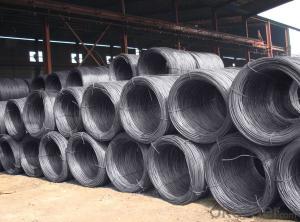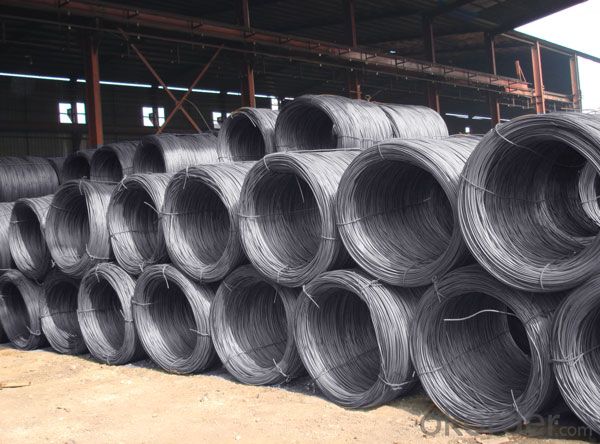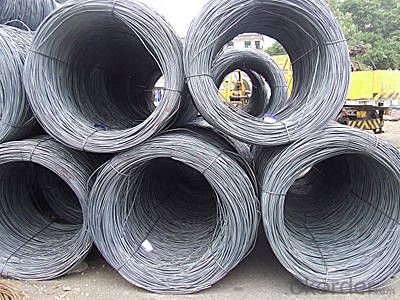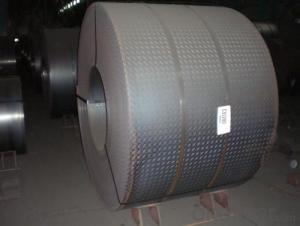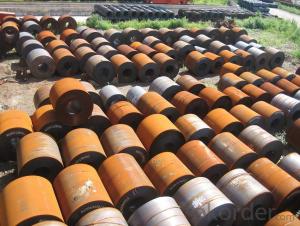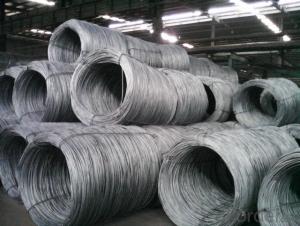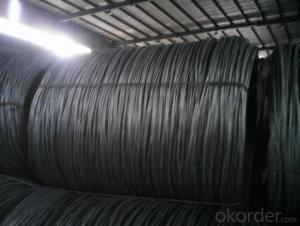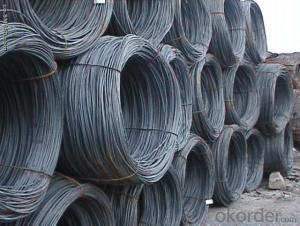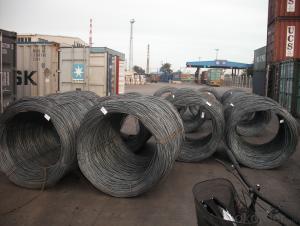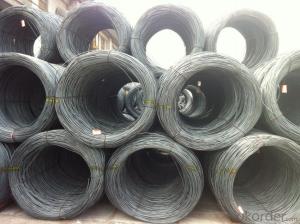hot rolled carbon steel wire rod Cold Heading Steel
- Loading Port:
- Tianjin
- Payment Terms:
- TT OR LC
- Min Order Qty:
- 30 m.t.
- Supply Capability:
- 45000 m.t./month
OKorder Service Pledge
Quality Product, Order Online Tracking, Timely Delivery
OKorder Financial Service
Credit Rating, Credit Services, Credit Purchasing
You Might Also Like
Packaging & Delivery
| Packaging Detail: | Packing: in coils, about 2 tons/coil or weight show each coil. shipment: in containers or by bulk |
| Delivery Detail: | 30 days |
Specifications
wire rod
1)Grade: Q195/235,SAE1006-1018B, H08A, 30MnSi , 62B-82B
2)Dia:5.5m-14mm
3)Price:$550-700 per ton
wire rod 1)Standard: Q195/235,SAE1006B/SAE1008B/SAE1010B/SAE1018B H08A, 30MnSi, 62B-82B 2)Dia:5.5mm-14mm 3)Packing: in coils 4)shipment: in containers or by bulk

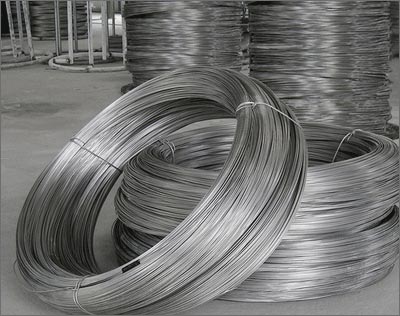
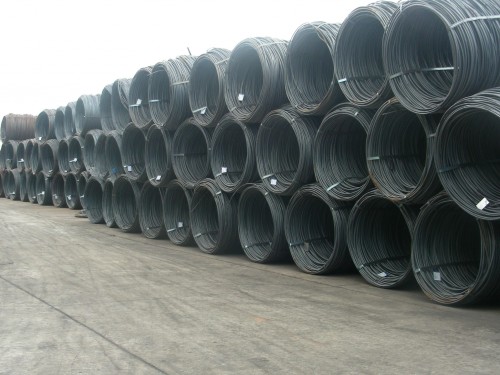
- Q: How is steel wire rod used in the manufacturing of wire for geotechnical applications?
- Steel wire rod is widely used in the manufacturing of wire for geotechnical applications due to its exceptional strength, durability, and versatility. Geotechnical applications primarily involve soil stabilization, erosion control, and reinforcing structures in civil engineering projects. Firstly, steel wire rod is used to manufacture geogrids, which are high-strength woven or welded wire mesh structures. Geogrids are employed to reinforce soil and provide stabilization in various applications such as retaining walls, embankments, and slopes. The steel wire rod is formed into a mesh pattern and then coated with a protective material to enhance its resistance to corrosion and environmental factors. Additionally, steel wire rod is utilized in the production of steel strand cables, which are essential in geotechnical engineering for post-tensioning applications. These cables are used to reinforce concrete structures such as bridges, buildings, and foundations. The steel wire rod is twisted into strands and then bundled together to form a high-tensile strength cable. This cable is embedded in concrete and post-tensioned to provide additional support and prevent structural failure. Moreover, steel wire rod is employed in the manufacturing of gabions, which are wire mesh containers filled with stones or other materials. Gabions are widely used for erosion control, slope stabilization, and retaining walls. The steel wire rod is woven or welded to form a mesh cage-like structure, which is then filled with stones. The gabions provide a flexible and permeable structure that can absorb impact, prevent soil erosion, and stabilize slopes. In summary, steel wire rod plays a crucial role in the manufacturing of wire for geotechnical applications. Its strength, durability, and adaptability make it an ideal material for reinforcing soil, stabilizing slopes, and reinforcing structures. Whether in the form of geogrids, steel strand cables, or gabions, steel wire rod contributes significantly to the safety, stability, and longevity of various geotechnical engineering projects.
- Q: How is the elongation of steel wire rod determined?
- The elongation of a steel wire rod is determined through a process called tensile testing. Tensile testing involves subjecting the steel wire rod to a controlled pulling force until it reaches its breaking point. During this test, the wire rod is gripped firmly at both ends and a tensile load is gradually applied. As the load is increased, the wire rod begins to elongate due to the applied force. The elongation of the steel wire rod is measured using an extensometer, which is a device that attaches to the specimen and measures the change in length as the load is applied. The extensometer provides precise measurements of the elongation, allowing for accurate determination of the wire rod's properties. The elongation measurement is usually expressed as a percentage, calculated by dividing the change in length by the original length of the wire rod and multiplying by 100. This value provides crucial information about the ductility and tensile strength of the steel wire rod, which are important factors in determining its suitability for various applications. Tensile testing and the determination of elongation are essential in quality control and material selection processes, as they help ensure that the steel wire rod meets the required mechanical properties and performance standards.
- Q: How is steel wire rod used in the manufacturing of wire forms for ventilation systems?
- Steel wire rod is used in the manufacturing of wire forms for ventilation systems as it provides the necessary strength and durability required for these applications. The wire rod is shaped and bent to create various wire forms, such as brackets, clips, and hangers, which are essential components of ventilation systems. These wire forms help to secure and support ventilation ducts, ensuring proper airflow and ventilation in buildings.
- Q: What are the safety requirements for steel wire rod used in mining wire ropes?
- The safe and reliable operation of mining equipment relies heavily on the safety requirements for steel wire rod used in mining wire ropes. These requirements play a vital role in preventing accidents, injuries, and fatalities that may result from wire rope failure. 1. When it comes to material composition, the steel wire rod for mining wire ropes must be made from high-quality steel with specific properties that can withstand the harsh conditions in mining operations. It is imperative that it possesses a high tensile strength, excellent fatigue resistance, and good ductility. 2. To ensure the wire rod's strength and durability, it must meet specific requirements that enable it to handle the load and stress associated with mining activities. It should be capable of withstanding heavy loads, sudden impacts, and repetitive bending and flexing without exhibiting signs of fatigue or failure. 3. The surface quality of the steel wire rod is of utmost importance. It should be smooth and free from any cracks, deformations, or defects that could compromise the integrity of the wire rope. A rough or uneven surface can lead to increased friction, wear, and potential failures during operation. 4. Dimensional accuracy is crucial for the wire rod to be compatible with other components of the wire rope system. It must adhere to precise dimensional tolerances to ensure proper assembly, fitting, and functionality of the wire rope. 5. Proper heat treatment processes, such as annealing or quenching, should be applied to the wire rod to enhance its mechanical properties. Heat treatment can improve its strength, hardness, and resistance to wear and corrosion, thereby making the wire rope more reliable and durable. 6. Rigorous quality control measures should be in place during the manufacturing process to ensure that the wire rod meets the specified safety requirements. Regular inspections, testing, and certifications should be carried out to verify the material's compliance with industry standards and regulations. 7. Accurate documentation and traceability records are essential for the steel wire rod used in mining wire ropes. This enables proper tracking of the material's origin, manufacturing process, and quality control procedures, ensuring accountability and facilitating necessary investigations or recalls. By adhering to these safety requirements, the integrity and reliability of the equipment are maintained. Regular inspections and maintenance of the wire ropes should also be conducted to ensure their continued safe operation.
- Q: What are the main factors affecting the market innovation of steel wire rod?
- The main factors affecting the market innovation of steel wire rod include technological advancements in manufacturing processes, changes in consumer demand and preferences, competition within the industry, government regulations and policies, and the availability and cost of raw materials.
- Q: How is steel wire rod used in the production of wire for mesh filters?
- The production of wire for mesh filters relies heavily on steel wire rod, which is an indispensable component. To ensure the quality and performance of the wire rod, it undergoes a series of steps. One common method is hot rolling, which involves heating the wire rod to high temperatures and passing it through rollers to shape it uniformly. After hot rolling, the wire rod is cooled and further processed to eliminate any scale or imperfections on its surface. This process guarantees a smooth and defect-free wire, essential for maintaining the mesh filter's quality. The wire rod is then drawn through dies to reduce its diameter and increase its length. This wire drawing process not only enhances the wire's strength but also improves its tensile properties. The drawn wire can be woven or welded to create the mesh filter. Weaving involves interlacing the wire in a crisscross pattern, suitable for finer mesh filters requiring precision. Conversely, welding involves joining individual wires using heat or pressure, resulting in a solid mesh structure. This method is commonly used for larger or more durable mesh filters. The choice of steel wire rod is critical as it determines the final product's quality and performance. Manufacturers carefully select the composition and tensile strength of the wire rod to meet the specific requirements of the mesh filter. It is crucial to use high-quality wire rod that offers excellent corrosion resistance, durability, and dimensional stability, ensuring the mesh filter's longevity and effectiveness. In conclusion, steel wire rod plays a vital role in the production of wire for mesh filters. Through processes such as hot rolling, wire drawing, and surface treatment, the wire rod achieves the desired properties. Whether woven or welded, the mesh structure determines the filter's precision, strength, and durability. By utilizing high-quality steel wire rod, manufacturers can produce superior mesh filters that effectively fulfill the filtration needs of various industries.
- Q: What are the common production processes for thorium-coated steel wire rod?
- The common production processes for thorium-coated steel wire rod include wire drawing, thorium coating deposition, heat treatment, and final wire rod finishing.
- Q: How is steel wire rod tested for resistance to erosion corrosion?
- Steel wire rod is tested for resistance to erosion corrosion through a series of specialized tests. These tests typically involve subjecting the wire rod to a corrosive environment, such as high-velocity flow of corrosive fluids or abrasive particles. The wire rod's resistance to erosion corrosion is evaluated by measuring factors like weight loss, surface degradation, or changes in mechanical properties after exposure to the corrosive environment. Additionally, advanced techniques like scanning electron microscopy and electrochemical methods may be used to further analyze the wire rod's resistance to erosion corrosion.
- Q: How are steel wire rods used in the production of wire ropes for cranes?
- Steel wire rods are used as the basic material in the production of wire ropes for cranes. These rods are first drawn through a series of dies to reduce their diameter and increase their length. Then, multiple wire rods are twisted and braided together to form a strong and flexible wire rope. This wire rope is then used in cranes for lifting and hoisting heavy loads due to its high strength and durability.
- Q: What are the different steelmaking processes used for steel wire rod production?
- Steel wire rod production utilizes several steelmaking processes, each boasting unique advantages and applications. The primary methods encompass: 1. Electric Arc Furnace (EAF): This involves scrap steel melting via an electric arc. EAF is renowned for its ability to handle diverse raw materials and produce varying steel grades. It is an energy-efficient approach widely employed in wire rod production. 2. Basic Oxygen Furnace (BOF): The BOF process employs hot metal derived from a blast furnace and introduces oxygen to reduce impurities and regulate carbon content. BOF is acclaimed for its high production capacity and capacity to fabricate an extensive array of steel grades. 3. Continuous Casting: Following EAF or BOF refining, continuous casting solidifies the molten steel into billets, blooms, or slabs. This technique allows for uninterrupted production and is commonly applied in wire rod production. 4. Ladle Refining Furnace (LRF): LRF is frequently used in conjunction with EAF or BOF. It serves as a secondary refining process, facilitating control over steel's chemical composition and temperature. LRF guarantees enhanced quality and cleaner steel, rendering it suitable for wire rod production. 5. Microalloying: Microalloying entails incorporating minute quantities of elements like vanadium, niobium, or titanium during the refining process. This enhances the strength, toughness, and other mechanical properties of the wire rod. Ultimately, the selection of a steelmaking process for wire rod production rests on factors such as desired steel grade, production capacity, energy efficiency, and cost-effectiveness. Each process exhibits distinct advantages and is employed based on specific requirements and considerations.
Send your message to us
hot rolled carbon steel wire rod Cold Heading Steel
- Loading Port:
- Tianjin
- Payment Terms:
- TT OR LC
- Min Order Qty:
- 30 m.t.
- Supply Capability:
- 45000 m.t./month
OKorder Service Pledge
Quality Product, Order Online Tracking, Timely Delivery
OKorder Financial Service
Credit Rating, Credit Services, Credit Purchasing
Similar products
Hot products
Hot Searches
Related keywords
